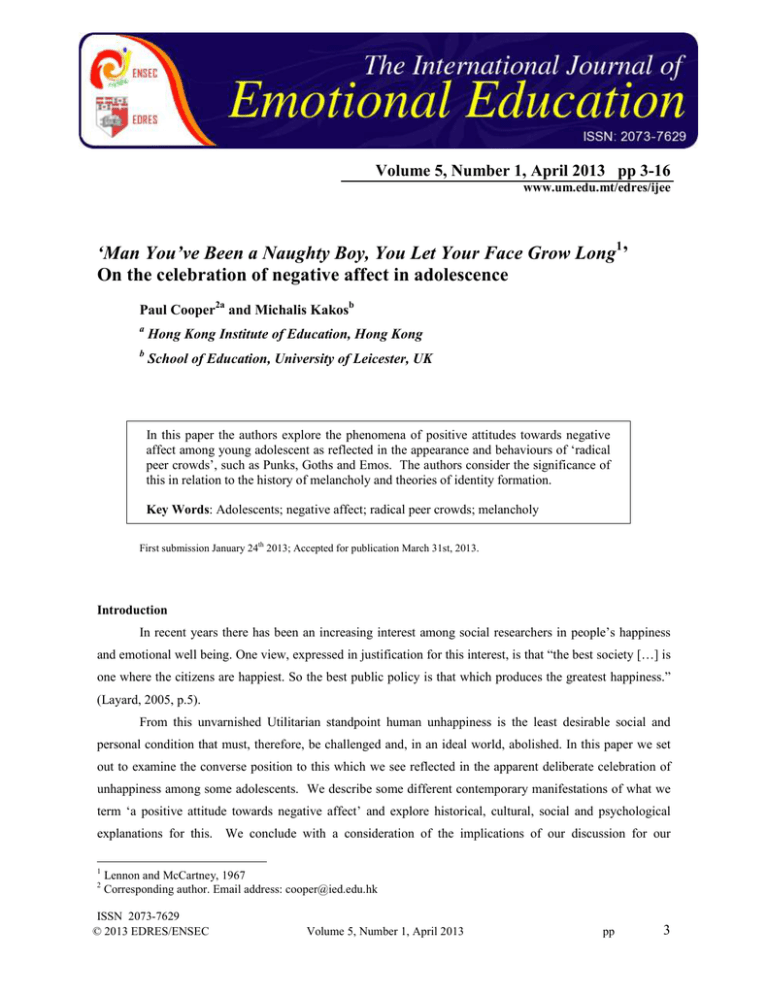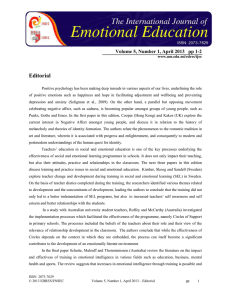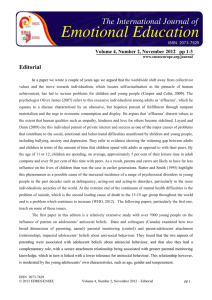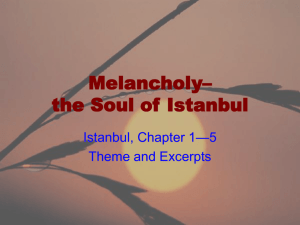‘Man You’ve Been a Naughty Boy, You Let Your Face... ’ On the celebration of negative affect in adolescence
advertisement

Volume 5, Number 1, April 2013 pp 3-16 www.um.edu.mt/edres/ijee ‘Man You’ve Been a Naughty Boy, You Let Your Face Grow Long1’ On the celebration of negative affect in adolescence Paul Cooper2a and Michalis Kakosb a Hong Kong Institute of Education, Hong Kong b School of Education, University of Leicester, UK In this paper the authors explore the phenomena of positive attitudes towards negative affect among young adolescent as reflected in the appearance and behaviours of ‘radical peer crowds’, such as Punks, Goths and Emos. The authors consider the significance of this in relation to the history of melancholy and theories of identity formation. Key Words: Adolescents; negative affect; radical peer crowds; melancholy First submission January 24th 2013; Accepted for publication March 31st, 2013. Introduction In recent years there has been an increasing interest among social researchers in people’s happiness and emotional well being. One view, expressed in justification for this interest, is that “the best society […] is one where the citizens are happiest. So the best public policy is that which produces the greatest happiness.” (Layard, 2005, p.5). From this unvarnished Utilitarian standpoint human unhappiness is the least desirable social and personal condition that must, therefore, be challenged and, in an ideal world, abolished. In this paper we set out to examine the converse position to this which we see reflected in the apparent deliberate celebration of unhappiness among some adolescents. We describe some different contemporary manifestations of what we term ‘a positive attitude towards negative affect’ and explore historical, cultural, social and psychological explanations for this. We conclude with a consideration of the implications of our discussion for our 1 2 Lennon and McCartney, 1967 Corresponding author. Email address: cooper@ied.edu.hk ISSN 2073-7629 © 2013 EDRES/ENSEC Volume 5, Number 1, April 2013 pp 3 understanding of the condition of adolescence and some of the possible contemporary cultural significances of ‘melancholia’. The nature of negative affect (NA) On the face of it, the term Negative Affect (NA) might in general be taken to signify the converse of Positive Affect (PA). PA can be thought of as reflecting a subjective sense of well-being (Veenhoven, 1991) and satisfaction with life and interpersonal relationships (Lewinsohn, et al., 1994) and, thus indicative of the presence of happiness. NA, on the other hand, has been defined in relation to anxiety and depression (Headley and Wearing, 1991). Depression has been characterized as a “pervasive sense of dissatisfaction” (Lewinsohn, et al., 1991, p.143) which is further characterized by a lack of pleasure in life, withdrawal from social contact and a profound sense of pessimism that is rooted in a distorted and dysfunctional view of reality (Beck and Alford, 2009). In short, PA tends to be seen as desirable and life enhancing, whilst NA is perceived to be undesirable and at worse pathological and destructive. One interesting finding that has emerged over the years is that over the life span, levels of NA decline whilst levels of PA tend to remain fairly stable (Lewinsohn, et al., 1994; Turk-Charles et al., 2001). This finding also has to be considered alongside the evidence suggesting that the incidence of psychosocial disorders among young people aged 12-24 (including mental health problems and delinquency) have increased significantly since 1945 in most of the advanced economies of the world (Rutter & Smith, 1995), whilst, over the same period, levels of self-reported happiness for people across the age range have declined (Layard, 2005; Layard & Dunn, 2009). It is compelling that different research traditions appear to identify sometimes identical, and at least complementary, factors as being associated with these trends as possible causal factors. These include: increased social isolation among people; the cultural shift from collectivism to individualism in prosperous societies (Layard, 2005; Layard and Dunn, 2009; Rutter and Smith,1995); lack of social skills (Bešic´& Kerr, 2009); introversion (Turk Charles, Reynolds & Gatz, 2001); distrust of neighbours (Layard and Dunn, 1999); and negative hedonic experiences and alienation (Elliott, 2000). Positive Attitude Towards Negative Affect in Youth Culture Consistent with a growing sense of unhappiness, is the evolution of modern youth culture and its links to what might be termed a positive attitude to NA. In the 1950s, the actors Marlon Brando and James Dean were both hugely popular in films such as ‘the Wild One’ and ‘Rebel Without a Cause’ in which they played disaffected youngsters with whom their teenage audience could identify. Rock ‘n’ Roll, the musical genre most closely identified with the birth of a distinct youth culture, drew its inspiration from the blues, which was originally a music reporting the plight of the disenfranchized, depressed and downtrodden African slaves in the 19th century America. These themes were carried forward to document the difficulties of later generations of African-Americans who in their versions of the blues often drew parallels between their own social conditions and those of their enslaved forebears. The key themes in the blues of loss, longing and ISSN 2073-7629 © 2013 EDRES/ENSEC Volume 5, Number 1, April 2013 pp 4 hedonistic escapism, are taken up wholesale in rock ‘n’ roll and carried forward in contemporary and subsequent popular music genres, including rhythm and blues, reggae, heavy metal, punk, emo and goth (Bricheno et al., 2003). Interestingly, this lineage is reflected in other influential historical musical traditions which have influenced youth culture, such as the folk traditions of Europe and North America which commonly report the lives and concerns of those at the bottom of the social pyramid. This tradition reaches its height of popularity in the 1960s, when it is most closely associated with the political protest song. Subsequently, there is a fusion of the folk and rock traditions, which is reflected in the more intentionally poetic and issues driven music of punk and post punk genres (Eyerman & Jamison, 1998). What is also noticeable about these developments is the increasingly widespread and intense emphasis on negative emotion in the lyric content and stylistic presentations associated with these forms. For example, from the mid-1970s, when punk reached prominence, a kind of anti-fashion became popular. This is characterized by garments which are torn and ragged, and sometimes held together with safety pins and adorned with chains. Hair styles are extreme, including shaven heads, extravagant ‘Mohican’ styles spike designs, often garishly coloured. Vivid facial make-up is worn by both male and female adherents, and images of violence and self-harm are displayed (Bricheno et al., 2003). Dictionary definitions of some of these youth culture terms help to emphasise the apparent celebration of NA, a sample of which are presented in appendix 1. A perusal of these definitions highlights the seminal influence of the term ‘punk’, the original meaning of which as a term of disparagement is subverted through its adoption as a label of choice. Like the music it describes this appropriation is a symbol of provocation and rebellion against the culture which deploys the term in its pejorative sense. There are parallels here with the ‘reclamation’ of intentionally insulting terms by members of the groups at whom they are aimed, by members of the same group such ’queer’ by some gay sub-cultures, or ’slut’ by some feminists (Godrej, 2011). Whilst such appropriations are often controversial, they can be interpreted as powerful reactions against often oppressive cultural norms which act to both distance the oppressed minority from the community of their oppressors and neutralize the tools of oppression (i.e. insulting labels) by adopting them as labels in which their bearers show pride. We suggest that the visual extremities to which members of these ‘radical peer crowds’ (Bešic ´ & Kerr, 2009) may, in some circumstances, serve a similar purpose to the adoption of pejorative labels, in that they mark not only estrangement from those who may be offended by such sights, but a complete inversion of the others’ perspectives and values. This view is consistent with certain well established sociological and literary analyses of the evolution and functions of youth culture. An important feature of these accounts is the central role played by ‘popular’ music trends, genres and sub-genres. These analyses tend to coalesce around the perceived shift away from “blandness, urbanity or introspection” (Mooney, 1968, p.67), reflected in the popular music of the 1940’s, towards the embracing of “primitive emotionalism” (Ibid, p.77) which is personified in the rock n’ roll of the 1950’s and the musical trends that followed from this. Crucially, it is argued, these musical and associated fashion trends are seen to reflect a rejection of the dishonesty and ISSN 2073-7629 © 2013 EDRES/ENSEC Volume 5, Number 1, April 2013 pp 5 hypocrisy of ‘the middle class Establishment’, which masks the ruthless exploitation of the weak by the power elite beneath a thin, brittle veneer of sentimentality and apparent sophistication, in favour of something that is claimed to be more authentic (Bettez-Halnon, 2005; Eyerman & Jamison, 1995; Mooney, 1968). This authenticity is marked by a directness in visual and auditory presentations which assault rather than soothe the casual observer/listener, and often replace supposed sophistication with apparent simplicity and deliberate crudeness. The use of safety pins as bodily adornments, for instance, can be seen to make sense when viewed in the context of what it resembles but definitely is not: i.e. jewelry, which is crafted for aesthetic appeal. The safety pin, on the other hand, has not been crafted for aesthetic purposes. Yet, it serves the same symbolic purpose as jewelry, being an object which reflects the wearer’s sense of values, which in this case models a rejection of conventional notions of what is and what is not seen to be valuable. Similarly, the glorification of self-harm makes sense, at least in part, because it inverts the customary human distaste for the sight of human blood (especially one’s own) and the usual desire to avoid injury to the self. The refusal to smile (a ubiquitous feature of many of these music and styles genres) is exactly that, namely the withholding of something that is conventionally expected. So as Bing Crosby, in the 1940’s, sings in the song ’White Christmas’: I’m dreaming of a white Christmas Just like the ones we used to know […] When tree tops glisten And children listen For the sound of sleigh bells in the snow. Razed in Black (2001), in, in the song ‘Oh My Goth’, sing(s): I know I prefer to hurt It seems to comfort me and burn I never asked for it – question I never wanted it to end […] I welcome misery with pride Takes turns in whipping me I bleed Enjoy the fantasy and greed Oh my goth Subject me to your world Oh my goth Take pleasure in my hurt. These lyrics are direct and unambiguous. They eschew rhetorical ornament and purport to report the authentic experience and vision of the singer, who is apparently not adopting a persona for the purpose of entertainment. This is not to say that popular songwriters of the late 20th and early 21st centuries have a ISSN 2073-7629 © 2013 EDRES/ENSEC Volume 5, Number 1, April 2013 pp 6 monopoly on dark subject matter in their work. On the contrary, there are songs about loss and failure from the era of the Great Depression in the USA (e.g. ‘Buddy Can You Spare a Dime’). However, whereas these songs align their bleak subjects with emotions of regret and the desire to escape from associated pain, they contrast with the sensibilities of some of their modern counterparts who seem to associate negative subjects with positive emotions: ‘misery with pride … pleasure in my hurt’. Melancholia, Then and Now In the 21st century, there is perhaps a tendency for the adult world to categorize these artifacts of modern youth culture as perverse, and to view them with a mixture of uncomprehending bewilderment, distaste, and concern as to the potential harm that may be associated with such apparently negative preoccupations. On the other hand, we may also (or alternatively), take a more considered view which interprets such phenomena in terms of developmental processes. From this perspective, teenage angst is seen as a problem associated with identity formation (e.g. Erikson, 1998). Although we agree with such association, we would argue that interpretations informed by such perspectives, lead unnecessarily either to the problematisation of this positive attitude towards negative affect shared by some adolescents (e.g. from an Eriksonian perspective (Erikson 1956; 1963), or associate it with a developmental phase which is to be escaped (Marcia, 1966; 1967) . We will return to these two important areas of concern later in this paper. In this section we consider the history of negative affect as a positive influence. This endeavor could begin almost anywhere in recorded history or even what is known of pre-history. For example, we might consider the cave paintings of wild animals, such as those found at Lascaux in France, as a celebration of unfulfilled desire. These early painters belonged to societies where the animals they painted were objects of enormous desire that were, at the same time, difficult to acquire. Another example would be the Neolithic temples that can be found on the islands of Malta which have been dated as early as 5,000 BC (Trump, 2003). A common feature of these temples is the ‘oracle’, which is a stone funnel which archeologists believe was used to amplify the voice of the priest and cause it to appear disembodied and to come from the ground. Given that these temples were almost certainly very dark places, the likelihood is that worshippers would be terrified by the experience. Which brings us to one of the cornerstones of western civilization, namely the Judeo-Christian view that all that is good and desirable comes from, God, but at a price which if not paid, brings divine retribution. Therefore, for our own sake, we must fear God. Moving on historically, the artist Albrecht Durer provides a striking contemplation on the nature of negative affect and its relation to humanity in his 1514 etching ‘Melencholia I’ (New York Metropolitan Museum of Art, 2000). The image depicts a winged and robed angelic figure wearing a garland around her head, a miserable facial expression and with her head in her hands. This is an unhappy angel. At her feet there is a sleeping beast, and close by a sleeping baby, the rest of the scene is crammed with scientific instruments and building tools. In the bottom right hand corner are four long nails that may echo the Crucifixion. According to the New York Metropolitan Museum of Art (2000) which holds the engraving, ISSN 2073-7629 © 2013 EDRES/ENSEC Volume 5, Number 1, April 2013 pp 7 Melencolia I is a depiction of the intellectual situation of the artist and is thus, by extension, a spiritual self-portrait of Dürer. In medieval philosophy, each individual was thought to be dominated by one of the four humors; melancholy, associated with black gall, was the least desirable of the four, and melancholics were considered most likely to succumb to insanity. Renaissance thought, however, also linked melancholy with creative genius; thus, at the same time that this idea changed the status of this humor, it made the self-conscious artist aware of the terrible risks that came with his gift. The winged personification of Melancholy, seated dejectedly with her head resting on her hand, holds a caliper and is surrounded by other tools associated with geometry, the one of the seven liberal arts that underlies artistic creation— and the one through which Dürer hoped to approach perfection in his own work (The New York Metropolitan Museum of Art, 2000). The key point here is the association between melancholia and the higher achievements of humanity, particularly in the realm creative insight. This theme is central to the Romantic poets of the 19th century, as exemplified by John Keats in his ‘Ode to Melancholy’(first published 1820): Ay, in the very temple of Delight Veil’d Melancholy has her sovran shrine… (John Keats, Ode to Melancholy, 1973 Edn, edited by Barnard) Though Keats’s vision says more about the bitter-sweet feelings inspired by melancholia, in that melancholy is reserved for only the most sensitive and adventurous: Though seen of none save him whose strenuous tongue Can burst Joy's grape against his palate fine; His soul shall taste the sadness of her might, And be among her cloudy trophies hung. (ibid) This perhaps explains why the angel in Durer’s engraving broods in a wakeful state, whilst the animal at his feet sleeps peacefully. It is as if the angel’s superior knowledge and understanding creates weighty responsibilities which are symbolized by the heavy bunch of keys about her waist. It has been suggested that in the modern world, melancholy is no longer the preserve of the artistic elite, but is part of the price that many modern human beings pay in return for what is often seen as among the most important possibilities of the human conditions, namely the individualism that come with the achievement of a heightened consciousness earned through self-awareness and reflection: The history of melancholy overlaps with the history of modern sensibility, because melancholy is an exacerbation of self-consciousness of an individual, who is the owner of and responsible for himself, that is whose personal autonomy is regarded as the supreme value (Klibanski et al., 1964). ISSN 2073-7629 © 2013 EDRES/ENSEC Volume 5, Number 1, April 2013 pp 8 An important feature of self-awareness and autonomy in an individualistic culture is their availability to all. Thus, whilst in earlier times the display of melancholia may have been deemed necessary in order to display the individual’s identity as a sensitive and creative person, in a world where everyone can aspire to these qualities the display becomes irrelevant, and perhaps, because of melancholia’s negative aspects, even undesirable. This may explain why, as Ehrenberg (2009) suggests: In the 19th century, during the romantic era, melancholy was at the crossroads of creation or genius or unreason. It is now the situation of everyone, because contemporary individualism consists of having democratized the idea that anyone could be exceptional. But depression has lost the positive aspect of the romantic melancholy: today it’s only an illness, an affective misery. Ehrenberg (2009, p.100). The Difference between Melancolia and Depression At this point it is important to stress the difference between melancholia and depression. Depression is clinically defined by the American Psychological Society (APA, 2007) as the presentation of five or more of the following symptoms for a continuous period of two weeks of more: • Depressed mood most of the day • Diminished interest or pleasure in all or most activities. • Significant unintentional weight loss or gain. • Insomnia or sleeping too much. • Agitation or psychomotor retardation noticed by others. • Fatigue or loss of energy. • Feelings of worthlessness or excessive guilt. • Diminished ability to think or concentrate, or indecisiveness. • Recurrent thoughts of death. (APA, 2000, p.356). The key dynamic issue here appears to be that of a diminution of the affective state, as reflected in prolonged reduced levels of or absence of motivation and hopefulness often associated with impairments in their cognitive performance. By contrast, melancholy, as demonstrated in the poetry of Keats referred to above, combines “pleasurable” and “displeasurable” feelings, including “sadness”, “longing”, and being “uplifted” (Brady & Haapala, 2003, p.7). In these ways depression can be seen as a potentially destructive state, whilst melancholy leans towards creativity and the refinement of understanding through reflection on possibly morbid subjects. The key point here is that, unlike depression, the pursuit of melancholy is ultimately positive and life affirming (Brady & Haapala, 2003). This distinction is extremely important, since the superficial presentation of these two diametrically opposed conditions can appear identical. It may even be the case that in some individuals depression and ISSN 2073-7629 © 2013 EDRES/ENSEC Volume 5, Number 1, April 2013 pp 9 melancholy are combined. It is beyond the scope of this paper to attempt to determine in detail ways of distinguishing between the presentation of depression and melancholy in adolescents who might be encountered by professionals such as teachers and social workers. However, as we will demonstrate in the following section, young people who present with an apparent positive attitude towards negative affect are often doing so in order to communicate important concerns that they have about the conditions of their existence. The extent to which these forms of expression are either a cause for concern or benign is determined by their meaning within the context of the individual’s life as he/she perceives it. Access to such meaning can only be gained through genuine, empathic engagement with the individual. Melancholia and the Transition to Adulthood Even in an individualistic society, full rights to individual expression are not evenly distributed. This is particularly the case for children and young people, whose status as ‘minors’ is defined by restrictions on their scope for autonomous action. This status is reinforced by the imposition on them of compulsory school attendance. The quasi-custodial aspect of schooling, which largely involves the performance of imposed roles, gives rise to a lack of differentiation between individuals. This pressure towards ‘undifferentiation’ (i.e. anonymity and uniformity), is likely to stimulate the quest for individuation. Barred from adult displays of the appearance of a differentiated identity (such as those reflected in apparent choice of job, lifestyle, exercise of political rights), pre-adult young people have limited scope for autonomy and self-expression. One area that is available to them is the private world of their emotions. In this respect melancholia (as the exacerbation of individual self-consciousness) can be viewed as a symbolic display of the passage towards adulthood which communicates differentiation and, perhaps superiority, among peers, whilst at the same time advertizing to adults a readiness to act and be treated as an individual, and so be admitted into the realms of adulthood. Difference, Individuation and Subjectification A further extension of our understanding of melancholia and negative affect as symbols linked to individuality, can be drawn from their power to attract attention due to their apparent similarity to pathological forms of being (i.e. severe unhappiness, clinical depression) and to their difference from what is generally considered as desirable or ‘normal’. From this perspective the deliberate projection of negative affect can be seen as performance symbolizing resistance to certain normative forms of being which are promoted by societies, that is, a rejection of the ‘tyranny of happiness’ (Elliott, 2000; 2007). As we have already noted, the view of negative affect as a form of resistance expressed through the dress code, behaviour or art popular among groups of young people, is not new. However, we would argue that such forms of self-presentation are often, explicitly or implicitly, seen as being problematic because, in challenging notions of social acceptability, they render implicated individuals an increased risk of developing deviant lifestyles or clinical pathologies, such as depression and suicidity (Adler & Adler, 2007). ISSN 2073-7629 © 2013 EDRES/ENSEC Volume 5, Number 1, April 2013 pp 10 The difference in the understanding that we are offering here is that we consider this resistance as part of a continuum which starts from birth and which possibly concludes with the physical death of the individual. We would like to place such understanding within the ‘intersubjective’ understanding of individuality (Foucault, 1987). We also associate this continuum with Butler’s (1997) theoretical account of the quest for autonomy as being driven less by a vision of an ideal identity, and more by a the impulse to avoid and reject other apparently available identities which the individual may believe him/herself to be being groomed for. From this perspective notions of choice and autonomy and the very idea that a fixed identity is ever actually achievable, are illusions. The choices that we believe ourselves to be making when we, for example, adopt the appearance and attitudes we associate with goth culture, are simply available moulds into which we fall (and fit, however imperfectly) whilst trying to avoid other moulds. As Butler puts it: “we never choose but that, paradoxically, initiates and sustains our agency” (as cited in Davies, 2006, p.427). The key aim is thus for the individual to achieve a degree of differentiation that reflects an acceptable level of individualism (in appearance, at least) (Davies, 2006). This process, therefore, is a performance that is intended to achieve recognition in the eyes of others of an image of ourselves that imbues us with a sense of our individuality as human beings (cf. Mead, 1913). From such a point of view, resistance, of the type associated with extreme peer crowds, is not a choice but the route to the (illusionary) achievement of autonomy and the (equally illusionary) formation of individuality. If there is a choice, this concerns the form of resistance that subjects perform at different stages in their lives. This choice refers to (and reveals) the particular discourse which particular subjects resist and seek to differ from, e.g. the tyranny of happiness. By studying this process we can reveal the nature and breadth of the social space within which individuals place themselves: the family, an institution, the neighbourhood, the nation, (their conception of) the ‘adults’ world’, the society at large. Another factor which determines this choice of form is the level of resistance which is considered as necessary for recognizability to be achieved in particular social settings and in particular circumstances. This means that individuals vary in the magnitude of the force they believe it necessary to exert in order to establish a satisfactory performance of personal distinctiveness. This factor can operate either as a guide towards the choice of certain forms of differing, such as becoming a ‘jock, ‘swot’ or ‘goth’, or as a basis for apparently choosing one of the forms of differing that have been already tried, such as ‘being a ‘jock’ was not powerful enough’; ‘being a ‘goth’ was too powerful’; ‘being a ‘swot’ met my needs to achieve the satisfactory level of distinctiveness without making me a ‘freak’. Such a view is not novel, as distinctiveness and the need for uniqueness are concepts which have existed in psychology for many years (e.g. Snyder & Fromkin, 1977) and have been applied to a variety of settings including marketing (Ruvio et al., 2008). In that sense, Negative affect and Melancholia, due to their strong association to forms of being that are largely considered as problematic or even abnormal can be particularly functional as symbols feeding the project of resistance and individuation by granting particularly high level of distinctiveness. ISSN 2073-7629 © 2013 EDRES/ENSEC Volume 5, Number 1, April 2013 What determines differences in pp 11 individuals’ levels of need in this respect is likely to be a function of social history and psychological make up. We suggest that due to both factors which guide the choice of the form of differing, -choice of social discourse and choice of level of difference-, negative affect and Melancholia as well as other extreme forms of differing, exercise a particular appeal in adolescence. It is at that period of development that the subjects are largely constructed with the reference (and resistance) to discourses beyond that of particular environments such as family, school or other. At that stage the difference is usually exercised in relation to wide societal conceptions of what is normal or acceptable. Also, just before entering the ‘adult world’ adolescents might justifiably seek to maximise their efforts to gain distinctiveness in the context of their project of developing their individuality. This process however, and the project of differing, although it may be more intense in adolescence, does not concern solely a particular stage in human development, neither do we associate it with any ‘identity crisis’ (Erikson, 1956; 1968; Marcia, 1966). Moreover, we suggest that the ‘lack of commitment’ (Marcia, 1966: 552) that adolescents exhibit to particular identities may not be the sign of an incomplete process of identity development, but could be considered as a temporary state during which adolescents test the level and the kind of distinctiveness that they gain. From such point of view, it is the distinctiveness that is to be generated by melancholia and negative affect that determines the level of adolescents’ commitment to the particular form of differing. Implications and Conclusions We have argued that the phenomenon of ‘a positive attitude towards negative affect’ as observed in some manifestations of youth culture is complex and serves a range of functions and needs. We have argued that this phenomenon can be related to the romantic tradition in art and literature, wherein it is associated with progress and enlightenment. We have, in turn, related this to modern and postmodern understandings of the human quest for identity. At this stage our conclusions from this analysis are for the most part highly tentative. Perhaps our most confident assertion is that so called ‘radical peer crowd’ manifestations should be of particular interest to the education community. Styles of presentation, such as goth, punk and emo, often reflect attempts to find a way of engaging with the world which needs to be understood in terms of an attempt at a creative response to uncongenial features of the perceived status quo. This suggests that the suppression of such forms of expression is not only counterproductive, that is, radical peer crowds are formed on the basis of an expectation of suppression, but it is also a hindrance to the further development of already functioning critical and creative faculties. This is not a call for a laissez faire attitude towards what many people might view as disturbing youth behaviour. On the contrary, our contention is that these manifestations should be seen for what they are, namely a form of communication that invites engagement. This may pose challenges to many schools, where the regulation of student dress and appearance are often seen as important factors in promoting social cohesion and reducing intergroup conflict (Thomas, 2008). On the face of it, the argument that we have ISSN 2073-7629 © 2013 EDRES/ENSEC Volume 5, Number 1, April 2013 pp 12 presented in this paper would appear to suggest that there are powerful educational implications to be drawn from engaging with the subcultures discussed here, given the strong possibility that membership of such these subcultures may reflect attempts to articulate complex responses to the world. At the time of writing this is a topical issue in the UK, where some police forces have begun to classify attacks on people related to their membership of ‘alternative subcultures’ as ‘hate crimes’ (Mail Online, 2013). This indicates a recognition of the legitimacy of these subcultures which may seem to be at odds with the apparent suppression of forms of expression associated with such subcultures inherent in some school dress codes. This leads to important questions about the ways in which schools accommodate and respect diversity among the members of their student communities and the ways in which this relates to the role of schooling in promoting positive andproactive citizenship. These issue sare beyond the scope of this paper. It is important to observe, however, that simply banishing these forms of sub cultural expression may contribute to the discrimination against members of these subcultures and foster feelings of alienation rather than the promotion of social inclusion. References Adler, P., & Adler, P. (2007). The Demedicalization of Self-Injury: From Psychopathology to Sociological Deviance, Journal of Contemporary Ethnography, 36(5), 537-570. APA, (2007). Diagnostic and Statistical Manual for Mental Disorders: DSM-IV-TR. Washington, D.C.: APA. Beck, A., & Alford, B. (2009). Depression: Causes and Treatment. Philadelphia: University of Pennsylvania Press. Bešic´, J., & Kerr, M. (2009). Punks, Goths, and Other Eye-Catching Peer Crowds: Do they Fulfill a Function for Shy Youths? Journal of Research on Adolescence, 19(1), 113-121. Bettez-Halnon, K. (2005). Alienation Incorporated: ‘F*** the Mainstream Music’ in the Mainstream. Current Sociology, 53(3), 441-464. Brady, E., & Haapala, A. (2003). Melancholy as an Aesthetic Emotion. Contemporary Aesthetics. Retrieved on 3rd April 2013 from: http://www.contempaesthetics.org/newvolume/pages/article.php?articleID=214 Bricheno, T., Nickol, T., & Winterson, J. (2003). Pop Music: The Text Book. London: Peters. Butler, J. (1997). The Psychic Life of Power: Theories in Subjection. Stanford, CA: Stanford University Press. Davies, B. (2006). Subjectification: the relevance of Butler's analysis for education. British Journal of Sociology of Education, 27(4), 425-438. ISSN 2073-7629 © 2013 EDRES/ENSEC Volume 5, Number 1, April 2013 pp 13 Ehrenberg, A. (2009). Weariness of the Self: Diagnosing the History of Depression in the Contemporary Age. Sydney: Macquarie University Press. Elliott, C. (2000). Pursued by Happiness and Beaten Senseless: Prozac and the American Dream. Hastings Center Report, 30(2), 7-12. Elliott, C. (2007). Against Happiness. Medicine, Health Care and Philosophy, 10(2), 167-174. Erikson, E. (1956). The problem of ego identity. Journal of the American Psychoanalytic Association, 46(1), 56-121. Erikson, E. (1963). Childhood and Society (2nd ed) New York: Norton. Erikson, E. (1968). Identity, Youth and Crisis. New York: Norton. Erikson, E. (1998). Youth: fidelity and diversity. Daedalus, 117(3), 1-24. Eyerman, R., & Jamison, A. (1998). Music and Social Movements: mobilizing traditions in the twentieth century. UK: Cambridge University Press. Foucault, M. (1987). The Ethics of Care for the Self as a Practice of Freedom: An interview with Michel Foucault on January 20, 1984. Philosophy & Social Criticism, 12, 112-131. Godrej, F. (2011). Spaces for Counter-Narratives: The Phenomenology of Reclamation, Frontiers: A Journal of Women Studies, 32(3), 111-133. Headey, B., & Wearing, A. (1991). Subjective well-being: A stocks and flows framework. In F. Strack, M. Argyle & N. Schwarz (Eds.), Subjective Well-Being (pp. 49-73). Oxford: Pergamon. Keats, J. (1973). Ode to Melancholy. In J. Barnard (Ed.), John Keats: The Complete Poems (pp. 348). Harmondsworth: Penguin Classics. Klibanski, R., Panofsky E., & Saxl. F. (1964). Saturn and Melancholy. New York: Basic. Layard, R. (2005). Happiness: Lessons from a New Science. London: Penguin. Layard, R., & Dunn, J. (2009). A good childhood: Searching for values in a competitive age. London: Penguin. Lennon, J., & McCartney, P (1967). 'I am the walrus,' (song) Sony/ATV Music Publishing. Lewinsohn, P. M., Roberts, R. E., Seeley. J. R., Rohde, P., Gotlib, I. H. & Hops, H. (1994). Adolescent psychopathology: II. Psychosocial risk factors for depression. Journal of Abnormal Psychology, 103(2), 302–315. ISSN 2073-7629 © 2013 EDRES/ENSEC Volume 5, Number 1, April 2013 pp 14 Mail Online (2013, 11 April) Police arrest first two suspects for hate crime against 'Emos' after murder of student who was targeted because she looked like a goth. Retrieved on 19th April 2013 from: http://www.dailymail.co.uk/news/article-2307552/Police-arrest-suspects-hate-crime-Emos-murderstudent-targeted-looked-like-goth.html?ito=feeds-newsxml Marcia, J. E. (1966). Development and validation of ego-identity status. Journal of Personality and Social Psychology, 3(5), 551-558. Marcia, J. E. (1967). Ego-identity status: Relationship to change in self-esteem, general maladjustment and authoritarianism. Journal of Personality, 35(1), 118-133. Mead, G. H. (1913). The Social Self. Journal of Philosophy, Psychology and Scientific Methods, 10, 374-380. Mooney, H. (1968). Popular Music since the 1920s: The Significance of Shifting Taste. American Quarterly, 20(1). New York Metropolitan Museum of Art (2000). Retrieved on 11th April 2013 from: http://www.metmuseum.org/toah/works-of-art/43.106.1 Rutter, M., & Smith, D. (Eds.). (1995). Psychosocial Disorders in Young People: time trends and their causes. Chichester: Wiley. Ruvio, A., Shoham, A., & Brenčič M. M. (2008). Consumers’ need for uniqueness: short-form scale development and cross cultural validation. International Marketing Review, 25(1), 33-53. Snyder, C. R., & Fromkin, H. L. (1977). Abnormality as a positive characteristic: the development and validation of a scale measuring need for uniqueness. Journal of Abnormal Psychology, 86(5), 518527. Thomas, R. (2008). What Schools Ban and Why. Westport, CT: Praeger. Trump, D. (2003). Prehistory and Temples. Malta: Midsea Books. Turk Charles, S., Reynolds, C., & Gatz, M. (2001). Age-Related Differences and Change in Positive and Negative Affect Over 23 Years. Journal of Personality and Social Psychology, 80(1), 136-151. Veenhoven, R. (1991). Is Happiness Relative? Social Indicators Research, 24, 1-34. ISSN 2073-7629 © 2013 EDRES/ENSEC Volume 5, Number 1, April 2013 pp 15 Appendix: Definitions Punk North American informal a worthless person (often used as a general term of abuse): you think any of these punks they got fighting today could stand up to Joe Louis? a criminal or thug: there’s never been a better time to take our streets back from the punks US (in prison slang) a passive male homosexual: he determined to be made into no one’s punk an inexperienced young person:[as modifier]: you were a nobody, a punk kid starting out 2 (also punk rock)[mass noun] a loud, fast-moving , and aggressive form of rock music, popular in the late 1970s: punk had turned pop music and its attendant culture on its head (also punk rocker)[count noun] an admirer or player of punk rock, typically characterized by coloured spiked hair and clothing decorated with safety pins or zips: punks fought Teds on the Kings Road on Saturday afternoons (Oxford Dictionaries online) Emo ‘a style of rock music resembling punk but having more complex arrangements and lyrics that deal with more emotional subjects’ (Oxford Dictionaries online). Goth ‘a style of rock music derived from punk, typically with apocalyptic or mystical lyrics’ (Oxford Dictionaries online). ISSN 2073-7629 © 2013 EDRES/ENSEC Volume 5, Number 1, April 2013 pp 16





